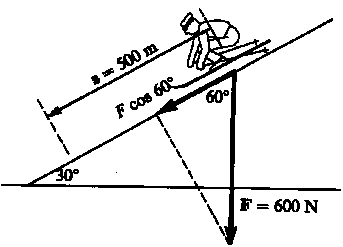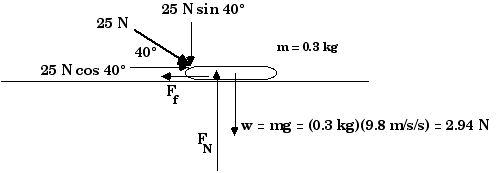
PHY 1151
Chapter 7; Work and Kinetic Energy
![]()
| ToC, Chapter 7 | Course Calendar |
![]()

PHY 1151
Chapter 7; Work and Kinetic Energy
![]()
| ToC, Chapter 7 | Course Calendar |
![]()
D7.1 How much work
is done by gravity on a skier weighing 600 N who slides 500 m down a hill
(measured along the hill) which makes an angle of 30° with the horizontal
as sketched in the figure?

W = F D cos ![]() = F D cos 60° = (600 N) (500 m) (0.50) = 150,000 J
= F D cos 60° = (600 N) (500 m) (0.50) = 150,000 J
D7.2 In playing shuffleboard, a long wooden stick is used to give
a push to a 0.3 kg puck and cause it to move across the floor. A player pushes
with a force of 25 N along the stick, inclined 40° to the ground. The coefficient
of friction between puck and floor is 0.10.
a) How much work is done on the puck by the stick as it moves a distance of 0.7 m?
b) What will be the puck's speed after it has moved that 0.7 m, assuming it started at rest?
c) From there the puck leaves the stick and slides across the floor. How far will it slide?

a)W = F D cos = (25 N) (0.7 m) (0.766) = 13.4 J
Remember, this is the work done by the stick. It is not the total or net work done on the puck (for the friction force also does work on the puck; however the weight and the normal force do not do any work on the puck).
b) Now we need the total work done on the puck.
Wtot = Wnet = Wstick + Wf + WN + Ww We just found the work done by the stick,
Wstick = 13.4 J Wf = Ff D cos 180° = Ff (0.7 m) (- 1)
Now we must pause and determine the friction force Ff,
Ff = µ FN = (0.10) FN And that means we must find the normal force, FN,
The sum of all the y-components of the forces must be zero since there is no acceleration in the y-direction,Fy = - (25 N)(0.643) + FN - 2.94 N = 0
FN = 2.94 N + 16.07 N = 19.01 N
Ff = µ FN = (0.10) FN = (0.10) (19.01 N) = 1.9 N
Wf = (1.9 N) (0.7 m) ( - 1) = - 1.33 JThe work done by the weight and by the normal force are both zero since these forces are perpendicular to the distance moved,
WN = 0
Ww = 0Therefore,
Wtot = Wnet = Wstick + Wf + WN + Ww
Wtot = Wnet = 13.4 J - 1.33 J + 0 + 0
Wtot = Wnet = 12.1 JWhat does this amount of work cause? From the work-energy theorem (that is, from conservation of energy), we know that work done on an object causes a change in its kinetic energy; that is,
W = KEf - KEi Since this puck starts at rest, we know
KEi = 0 so that
W = KEf = (1/2) m vf2 = (1/2) (0.3 kg) vf2 = 12.1 J
vf2 = 12.1 J/0.15 kg = 80.7 m2/s2
vf = 9.0 m/sc) Now what happens? At the end of the 0.7 m the stick no longer exerts a force and work is done only by the friction force. The puck starts out with 12.1 J of KE and finally comes to rest a distance D from where the stick released it. Again, we apply the work-energy theorem,
W = - Ff D = - (1.9 N) D
W = KEf - KEi = 0 - 12.1 J
- ( 1.9 N ) D = - 12.1 J
D = ( 12.1 / 1.9 ) m
Cost = (1284 kW-h)($0.115/kW-h) = $147.66
E = 1284 kW-h = 1284 x 103 W-h [ (J/s)/W] ( 3600 s/h )
E = 4.62 x 109 J
E = P t = (0.25 mW) (1 h) ( ) (
) (
) = 0.9 J
D7.5 The power of a boat’s motor at a speed of 40.0
km/h is 22.0 kW. If the power is 15% greater while pulling a skier at the
same speed, what is the tension in the tow rope?
P = F v (assuming F and v are parallel)

P = F v
As usual, we must change the speed from units of km/h to units of m/s
This is Fwater, the force the water exerts on the
boat.
When a skier is towed the power is 15% greater,

Now the net force is
and that is the force that goes into
This is the tension in the ski tow rope
D7.6 What is the kinetic energy of a 1750 kg car traveling
at 80 km/h?
As usual, we must change the speed from units of km/h to units of m/s
D7.7 Below are data for eight air track gliders with different
masses and speeds. Calculate the values of their kinetic energies.

KE = (1/2)
m v2
A) KE = (1/2) (0.225) (0.85 m/s)2
= 0.0813 J
B) KE = (1/2) (0.225) (0.90 m/s)2
= 0.0911 J
C) KE = (1/2) (0.250) (0.35 m/s)2
= 0.0153 J
D) KE = (1/2) (0.250) (0.50 m/s)2
= 0.0313 J
E) KE = (1/2) (0.267) (0.65 m/s)2
= 0.0564 J
F) KE = (1/2) (0.315) (0.82 m/s)2
= 0.1059 J
G) KE = (1/2) (0.450) (0.45 m/s)2
= 0.0456 J
H) KE = (1/2) (0.450) (0.52 m/s)2
= 0.0608 J
D7.8 The pilot of the first successful human-powered, heavier-than-air
flight could generate an average of 0.32 kW (0.43 hp) during the flight. The aircraft
covered 2.4 km at an average speed of 4.1 m/s. How much energy was expended during
the flight?
v = ![]()
![]() t
=
t
= ![]() =
= ![]() =
= ![]() = 585 s
= 585 s
Energy = (0.32 kW)(585 s)
Energy = (320 W)(585 s)( ![]() )
)
Energy = 187,000 J
![]()
| ToC, Chapter 7| Course Calendar |
![]()
(c) 2005, Doug Davis; all rights reserved.